Sediment and Radioactivity Transport in the Bohai, Yellow, and East China Seas: A Modeling Study
Abstract
1. Introduction
2. Materials and Methods
2.1. GOCI Data
2.2. Model Description
2.2.1. Coupled Wave–Circulation Model
2.2.2. Sediment Transport Model
2.2.3. Radioactivity Transport Model
2.3. Model Setup
2.4. Model Forcing
2.5. Scenarios of the 137Cs Release
3. Results
3.1. Validation of Tide and Wind-Wave Model Predictions
3.2. Comparison of Model Prediction with Measurements of Total Suspended Sediment Concentration
3.3. Results of Calculations for the Scenarios of Potential Release of 137Cs from Four NPP Locations
4. Discussion
Author Contributions
Funding
Data Availability Statement
Acknowledgments
Conflicts of Interest
References
- Doxaran, D.; Lamquin, N.; Park, J.E.; Mazeran, C.; Ryu, J.H.; Wang, M.; Poteau, A. Retrieval of the seawater reflectance for suspended solids monitoring in the East China Sea using MODIS, MERIS and GOCI satellite data. Remote Sens. Environ. 2014, 146, 36–48. [Google Scholar] [CrossRef]
- Choi, J.K.; Park, Y.J.; Ahn, J.H.; Lim, H.S.; Eom, J.; Ryu, J.H. GOCI, the world’s first geostationary ocean color observation satellite, for the monitoring of temporal variability in coastal water turbidity. J. Geophys. Res. 2012, 117, C09004. [Google Scholar] [CrossRef]
- Min, J.E.; Choi, J.K.; Yang, H.; Lee, S.; Ryu, J.H. Monitoring changes in suspended sediment concentration on the southwestern coast of Korea. J. Coast. Res. 2014, 70, 133–138. [Google Scholar] [CrossRef]
- Min, J.E.; Ryu, J.H.; Park, Y.J. An analysis of the relationship between inherent optical properties and ocean color algorithms around the Korean waters. Korean J. Remote Sens. 2015, 31, 473–490. [Google Scholar] [CrossRef][Green Version]
- Blumberg, A.F. A Primer for ECOMSED; Version 1.3; HydroQual Inc.: Mahwah, NJ, USA, 2002; p. 194. [Google Scholar]
- Choi, B.H.; Mun, J.Y.; Seok, K.J. Wintertime suspended sediment simulation in the Huanghai and East China Seas. Acta Oceanol. Sin. 2005, 24, 46–59. [Google Scholar]
- Lu, J.; Qiao, F.L.; Wang, X.H.; Wang, Y.G.; Teng, Y.; Xia, C.S. A numerical study of transport dynamics and seasonal variability of the Yellow River sediment in the Bohai and Yellow seas. Estuar. Coast. Shelf. Sci. 2011, 95, 39–51. [Google Scholar] [CrossRef]
- Bian, C.; Jiang, W.; Greatbatch, R.J. An exploratory model study of sediment transport sources and deposits in the Bohai Sea, Yellow Sea, and East China Sea. J. Geophys. Res. Oceans 2013, 118, 5908–5923. [Google Scholar] [CrossRef]
- Warner, J.C.; Sherwood, C.R.; Signell, R.P.; Harris, C.K.; Arango, H.G. Development of a three-dimensional, regional, coupled wave, current, and sediment-transport model. Comput. Geosci. 2008, 34, 1284–1306. [Google Scholar] [CrossRef]
- Qiao, L.; Zhong, Y.; Wang, N.; Zhao, K.; Huang, L.; Wang, Z. Seasonal transportation and deposition of the suspended sediments in the Bohai Sea and Yellow Sea and the related mechanisms. Ocean Dyn. 2016, 66, 751–766. [Google Scholar] [CrossRef]
- Buesseler, K.; Dai, M.; Aoyama, M.; Benitez-Nelson, C.; Charmasson, S.; Higley, K.; Maderich, V.; Masque, P.; Morris, P.J.; Oughton, D.; et al. Fukushima Daiichi-derived radionuclides in the ocean: Transport, fate, and impacts. Annu. Rev. Mar. Sci. 2017, 9, 173–203. [Google Scholar] [CrossRef]
- Periáñez, R.; Bezhenar, R.; Brovchenko, I.; Duffa, C.; Iosjpe, M.; Jung, K.T.; Kim, K.O.; Kobayashi, T.; Liptak, L.; Little, A.; et al. Marine radionuclide transport modelling: Recent developments, problems and challenges. Environ. Model. Softw. 2019, 122, 104523. [Google Scholar] [CrossRef]
- Maderich, V.; Jung, K.T.; Brovchenko, I.; Kim, K.O. Migration of radioactivity in multi-fraction sediments. Environ. Fluid Mech. 2017, 17, 1207–1231. [Google Scholar] [CrossRef]
- Zhang, Y.; Baptista, A.M. SELFE: A semi-implicit Eulerian-Lagrangian finite-element model for cross-scale ocean circulation. Ocean Model. 2008, 21, 71–96. [Google Scholar] [CrossRef]
- Roland, A.; Zhang, Y.; Wang, H.V.; Meng, Y.; Teng, Y.; Maderich, V.; Brovchenko, I.; Dutour-Sikiric, M.; Zanke, U. A fully coupled wave-current model on unstructured grids. J. Geophys. Res. Oceans 2012, 117, C00J33. [Google Scholar] [CrossRef]
- Zhang, Y.; Ye, F.; Stanev, E.; Grashorn, S. Seamless cross-scale modelling with SCHISM. Ocean Model. 2016, 102, 64–81. [Google Scholar] [CrossRef]
- Maderich, V.; Heling, R.; Bezhenar, R.; Brovchenko, I.; Jenner, H.; Koshebutskyy, A.; Kuschan, A.; Terletska, K. Development and application of 3D numerical model THREETOX to the prediction of cooling water transport and mixing in the inland and coastal waters. Hydrol. Processes 2008, 22, 1000–1013. [Google Scholar] [CrossRef]
- Pinto, L.; Fortunato, A.B.; Zhang, Y.; Oliveira, A.; Sancho, F.E.P. Development and validation of a three-dimensional morphodynamic modelling system for non-cohesive sediments. Ocean Model. 2012, 57–58, 1–14. [Google Scholar] [CrossRef]
- Umlauf, L.; Burchard, H. A generic length-scale equation for geophysical turbulence models. J. Mar. Res. 2003, 61, 235–265. [Google Scholar] [CrossRef]
- Kantha, L.H.; Clayson, C.A. An improved mixed layer model for geophysical applications. J. Geoph. Res. 1994, 99, 235–266. [Google Scholar] [CrossRef]
- Van Ledden, M. Sand-Mud Segregation in Estuaries and Tidal Basins. Ph.D. Thesis, Delft University of Technology, Delft, The Netherlands, 2003. [Google Scholar]
- Van Rijn, L.C. Sediment transport. Part II: Suspended load transport. J. Hydraul. Eng. 1984, 110, 1613–1641. [Google Scholar] [CrossRef]
- Van Rijn, L.C. Sediment transport. Part I: Bed load transport. J. Hydraul. Eng. 1984, 110, 1431–1456. [Google Scholar] [CrossRef]
- Ariathurai, C.R.; Arulanandan, K. Erosion rates of cohesive soils. J. Hydraul. Div. 1978, 104, 279–282. [Google Scholar] [CrossRef]
- Winterwerp, J.C.; van Kesteren, W.G. Introduction to the Physics of Cohesive Sediment in the Marine Environment; Developments in Sedimentology Series; Elsevier: Amsterdam, The Netherlands, 2004; Volume 56. [Google Scholar]
- Periáñez, R.; Brovchenko, I.; Jung, K.T.; Kim, K.O.; Maderich, V. The marine kd and water/sediment interaction problem. J. Environ. Radioact. 2018, 129, 635–647. [Google Scholar] [CrossRef] [PubMed]
- Boudreau, B.P. Diagenetic Models and Their Implementation; Springer: Berlin/Heidelberg, Germany; New York, NY, USA, 1997; pp. 178–188. [Google Scholar]
- Maderich, V.; Maderich, V.; Kim, K.O.; Brovchenko, I.; Kivva, S.; Kim, H. Scavenging processes in multicomponent medium with first-order reaction kinetics: Lagrangian and Eulerian modeling. Environ. Fluid Mech. 2021, 21, 817–842. [Google Scholar] [CrossRef]
- Periáñez, R.; Bezhenar, R.; Brovchenko, I.; Jung, K.T.; Kim, K.O.; Kamidaira, Y.; Kobayashi, T.; Liptak, L.; Maderich, V.; Min, B.I.; et al. Fukushima 137Cs releases dispersion modelling over the Pacific Ocean. Comparisons of models with water, sediment and biota data. J. Environ. Radioact. 2019, 198, 50–63. [Google Scholar] [CrossRef] [PubMed]
- Choi, B.H. The sand transport in the Yellow Sea. In Sedimentation in the Yellow Sea Coasts; Choi, B.H., Ed.; Korean Society of Coastal and Ocean Engineers: Seoul, Korea, 2003; pp. 39–52. [Google Scholar]
- Choi, B.H.; Kim, K.O.; Eum, H.M. Digital bathymetric and topographic data for neighboring seas of Korea. J. Korean Soc. Coast. Ocean Eng. 2002, 14, 41–50, (In Korean with English Abstract). [Google Scholar]
- GEBCO (General Bathymetric Chart of the Oceans). Available online: https://www.gebco.net/data_and_products/gridded_bathymetry_data/ (accessed on 21 December 2021).
- ERA-Interim. Available online: https://www.ecmwf.int/en/forecasts/datasets/reanalysis-datasets/era-interim (accessed on 21 December 2021).
- HYCOM (Hybrid Coordinate Ocean Model). Available online: https://hycom.org/ (accessed on 12 December 2021).
- Egbert, G.D.; Erofeeva, S.Y. Efficient inverse modeling of barotropic ocean tides. J. Atmos. Ocean. Technol. 2002, 19, 183–204. [Google Scholar] [CrossRef]
- Vorosmarty, C.J.; Fekete, B.M.; Tucker, B.A. Global River Discharge, 1807–1991, Version. 1.1 (RivDIS); ORNL DAAC: Oak Ridge, TN, USA, 1998. [CrossRef]
- KHOA (Korea Hydrographic and Oceanographic Agency). Available online: http://www.khoa.go.kr (accessed on 12 December 2021).


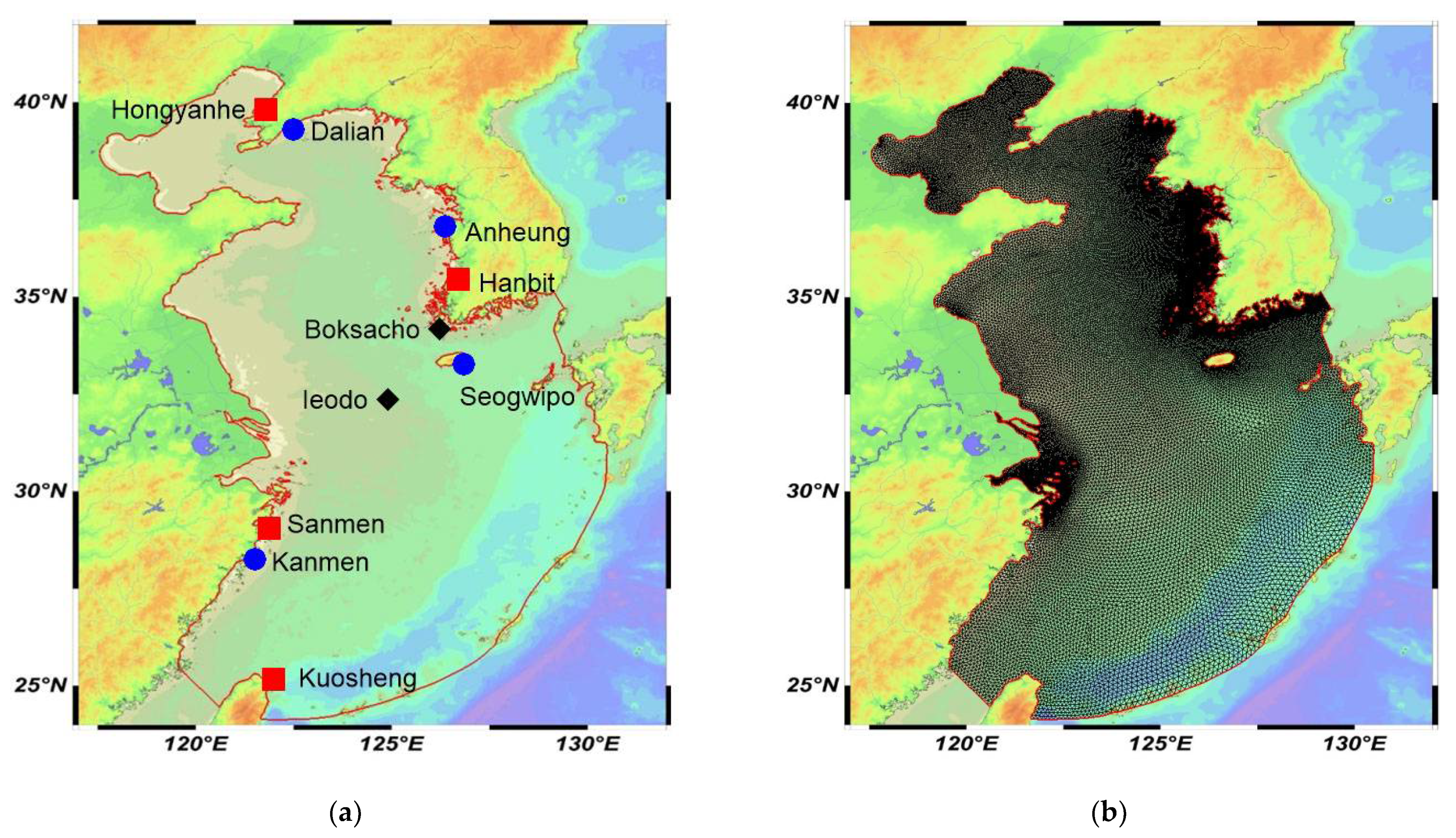

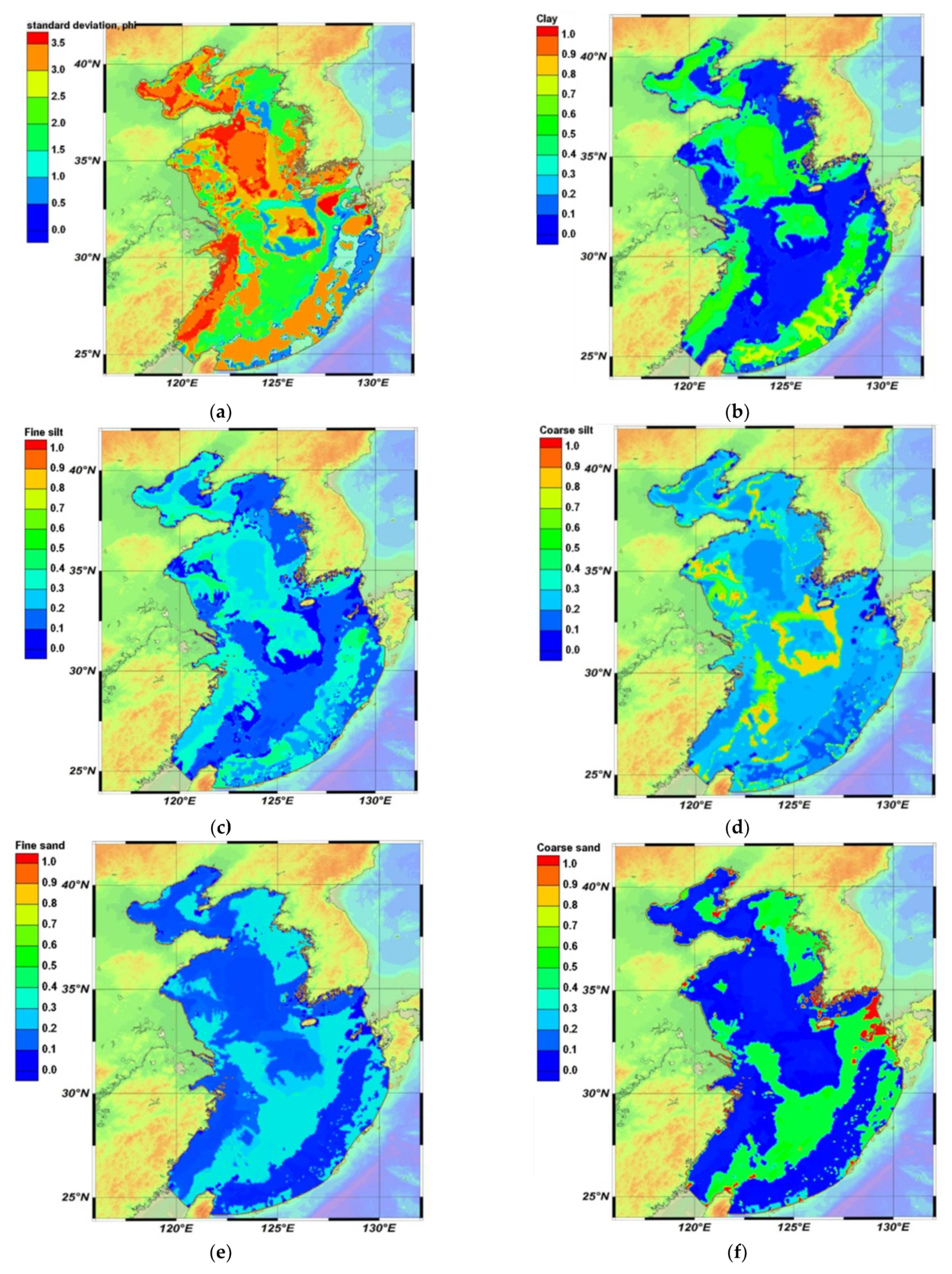

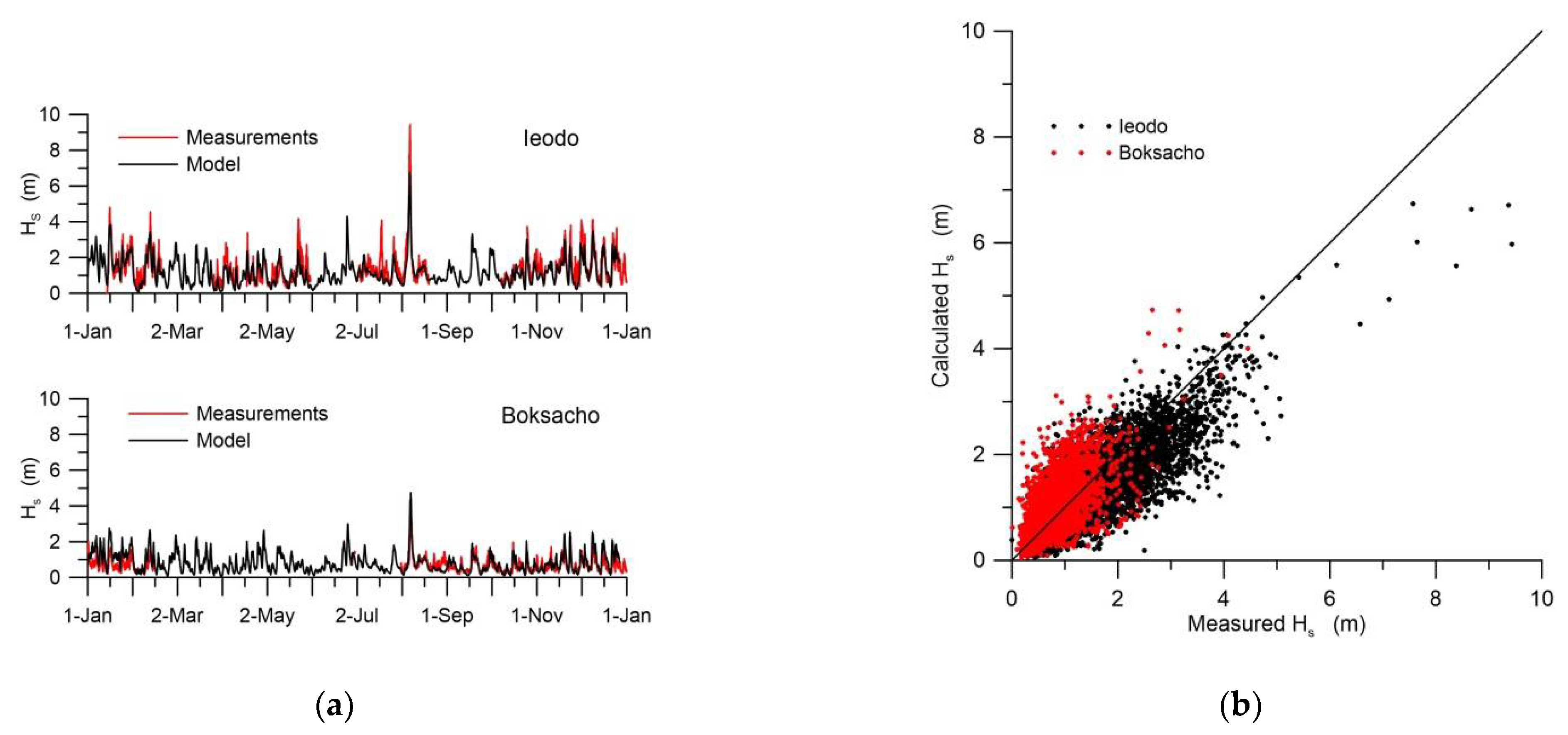

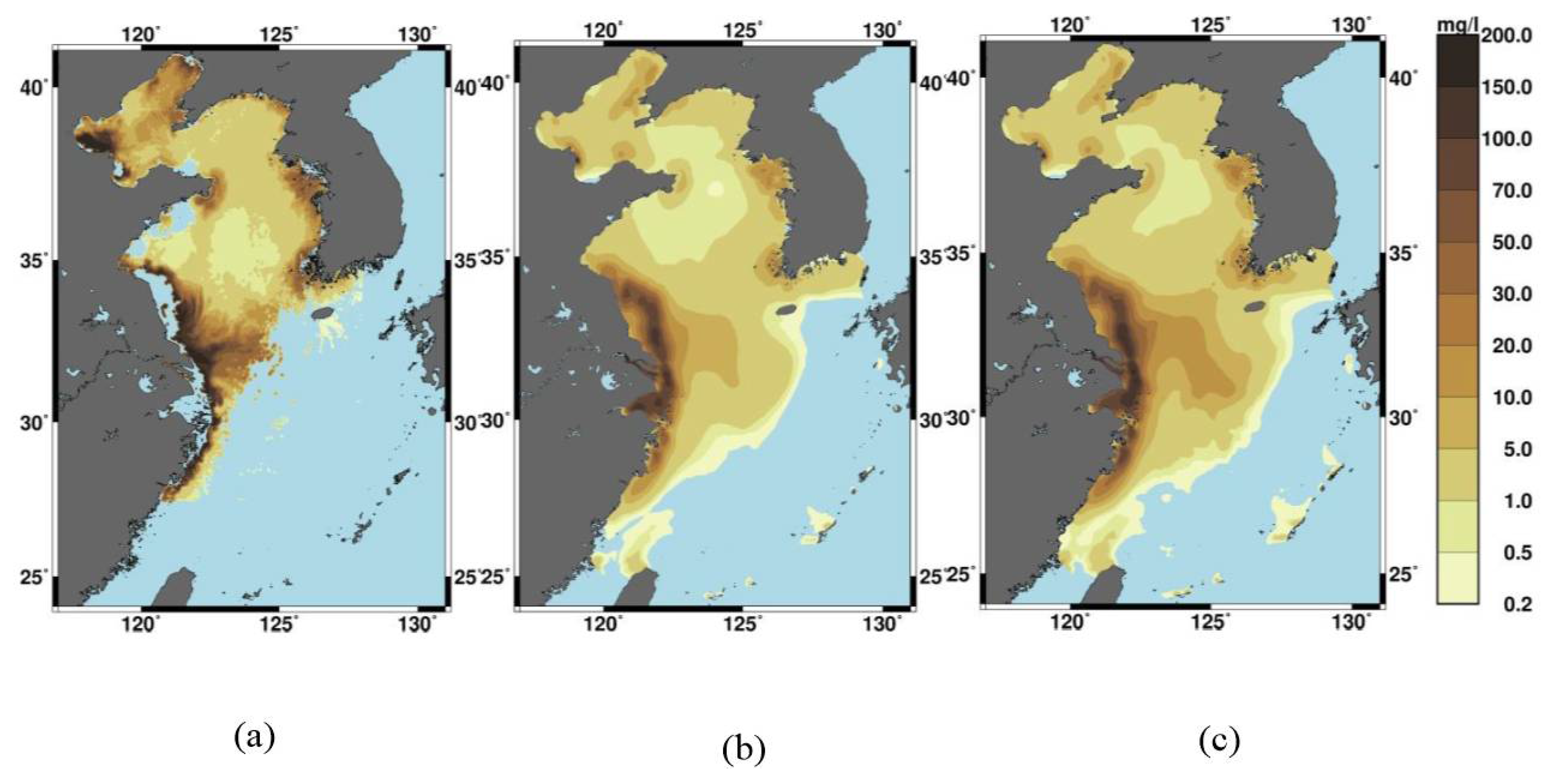
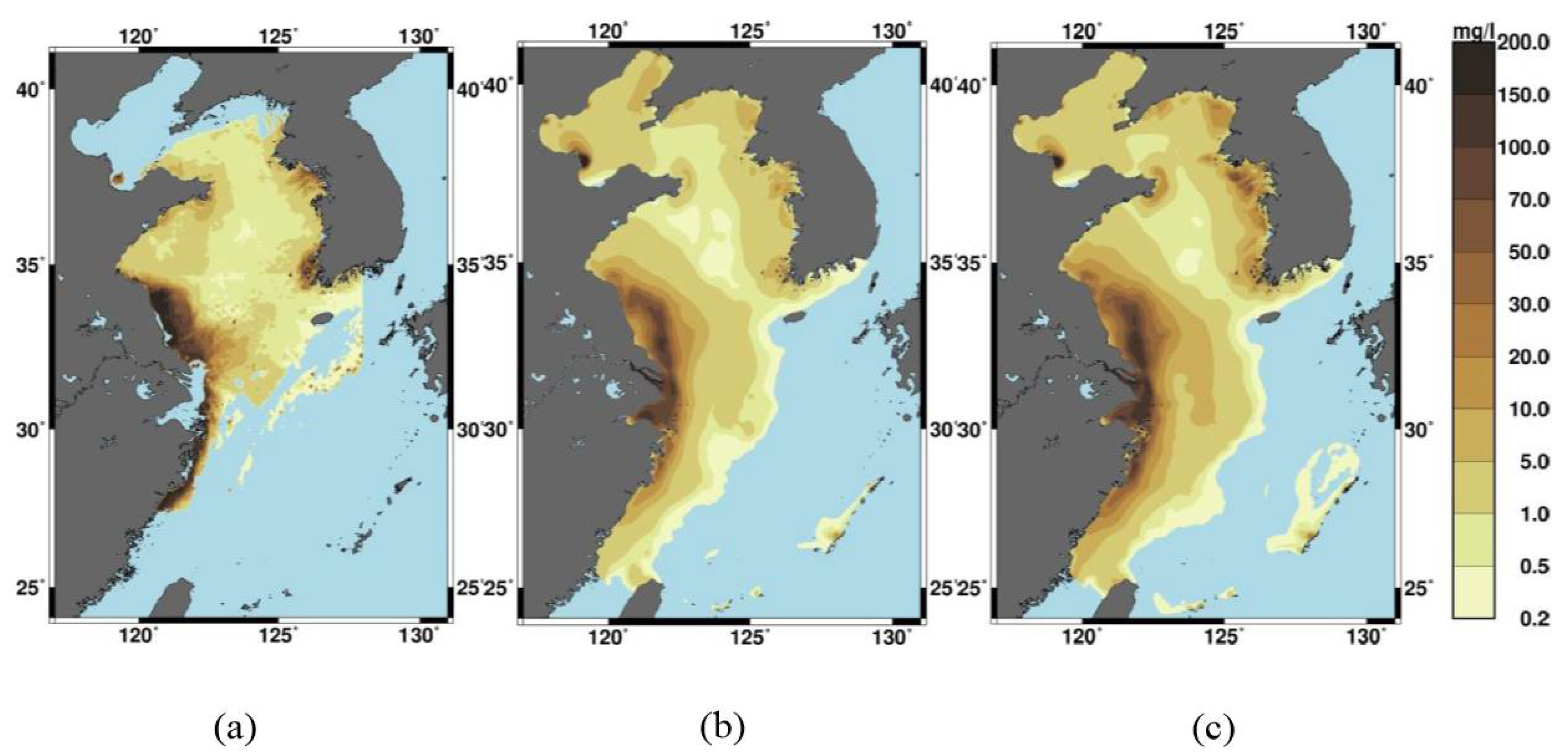

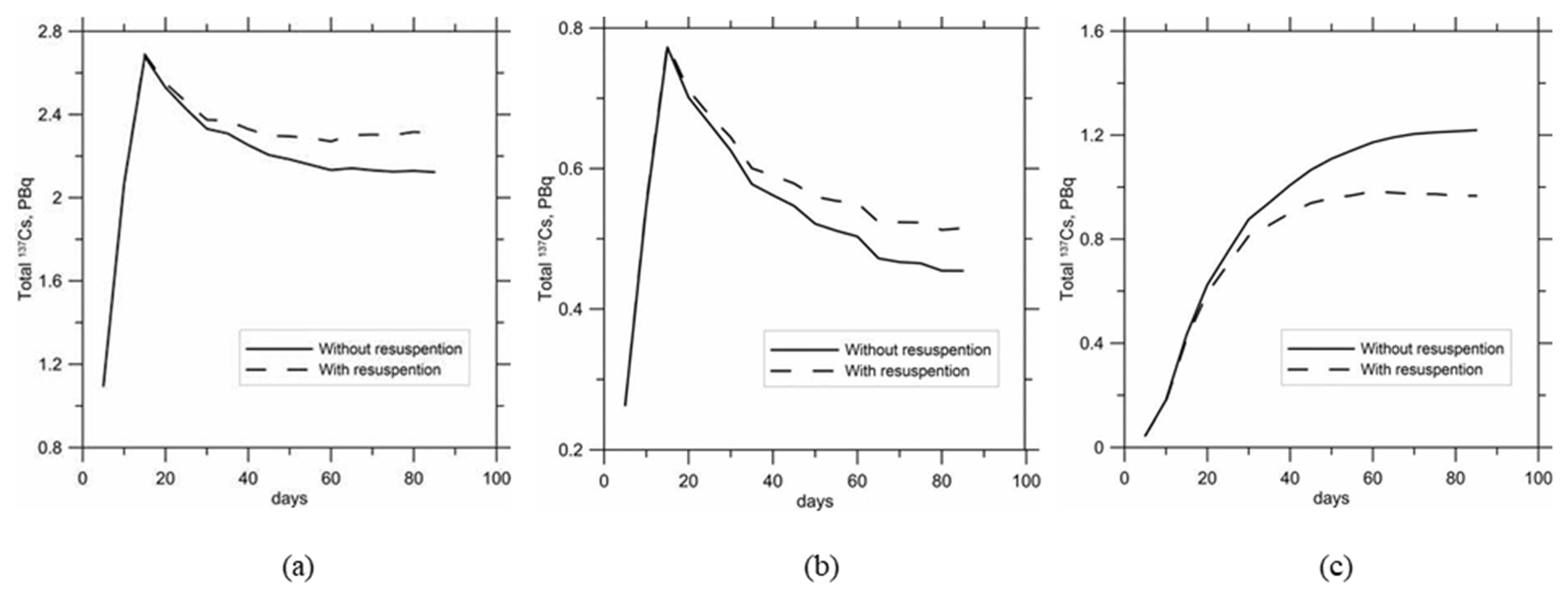
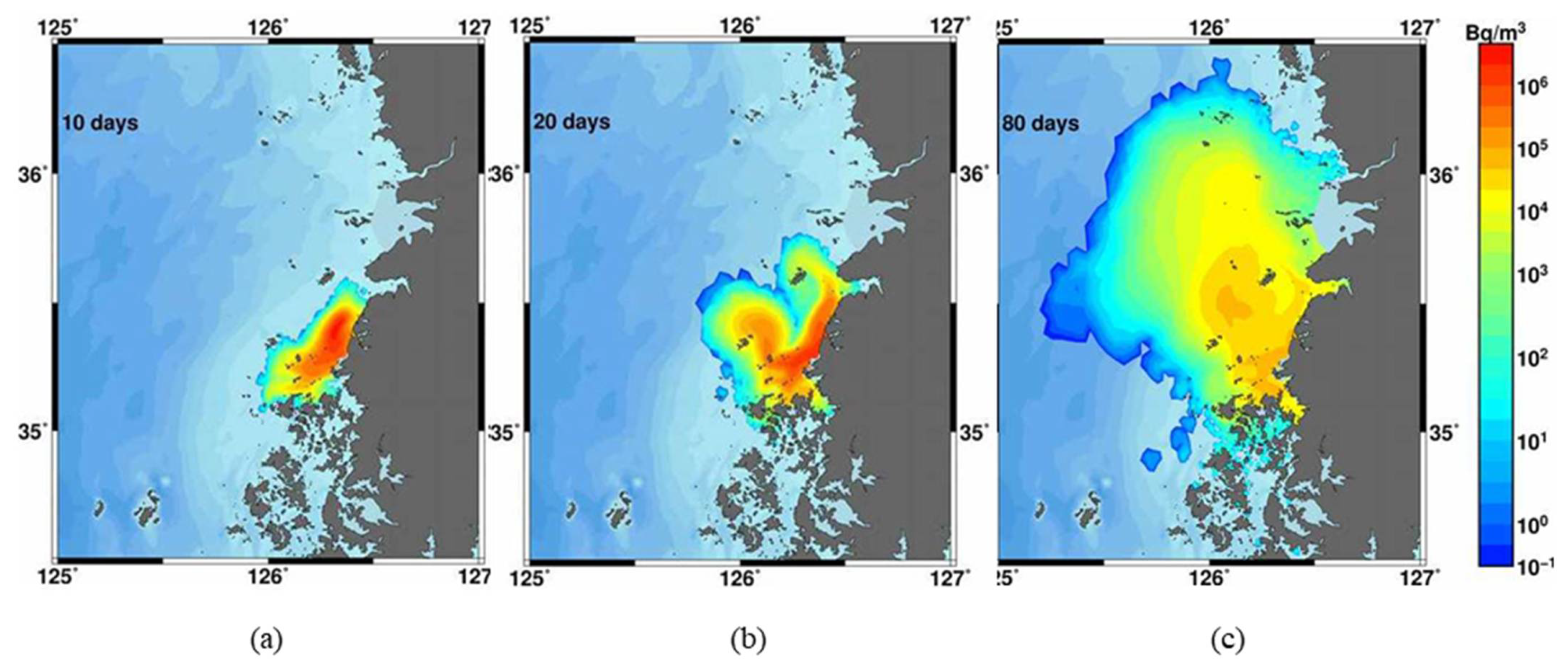

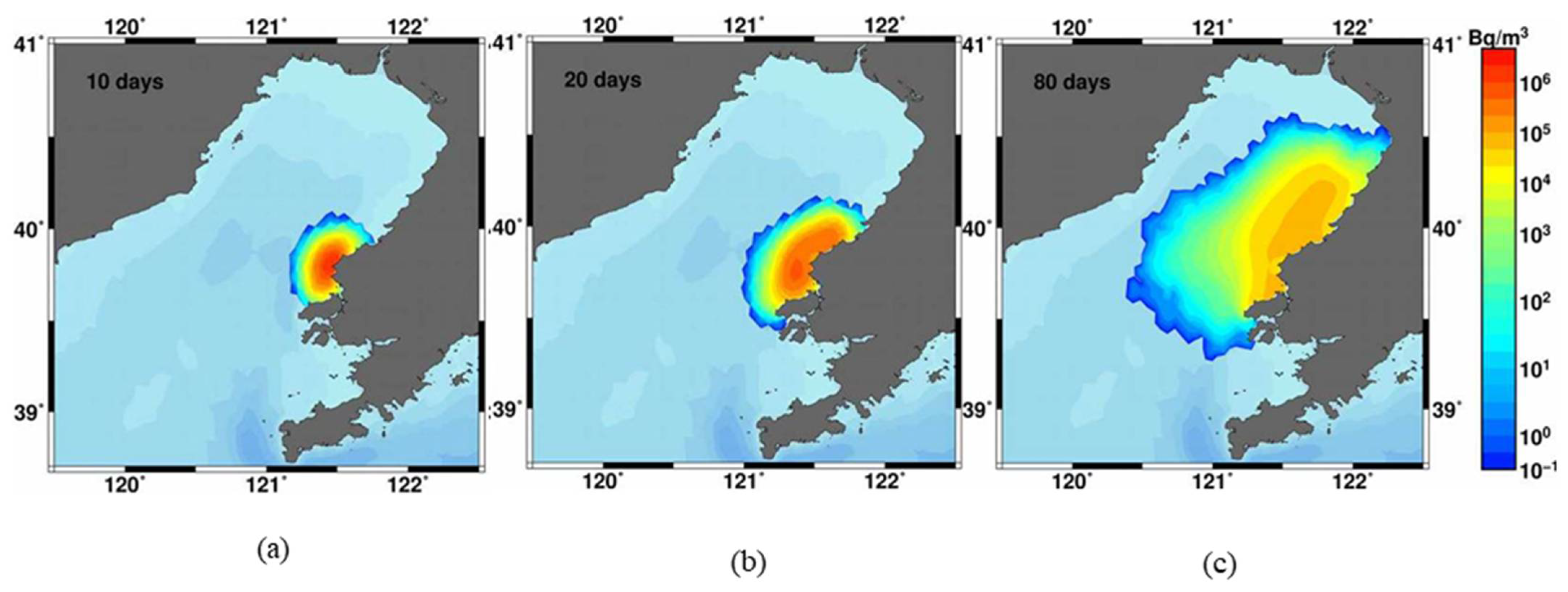
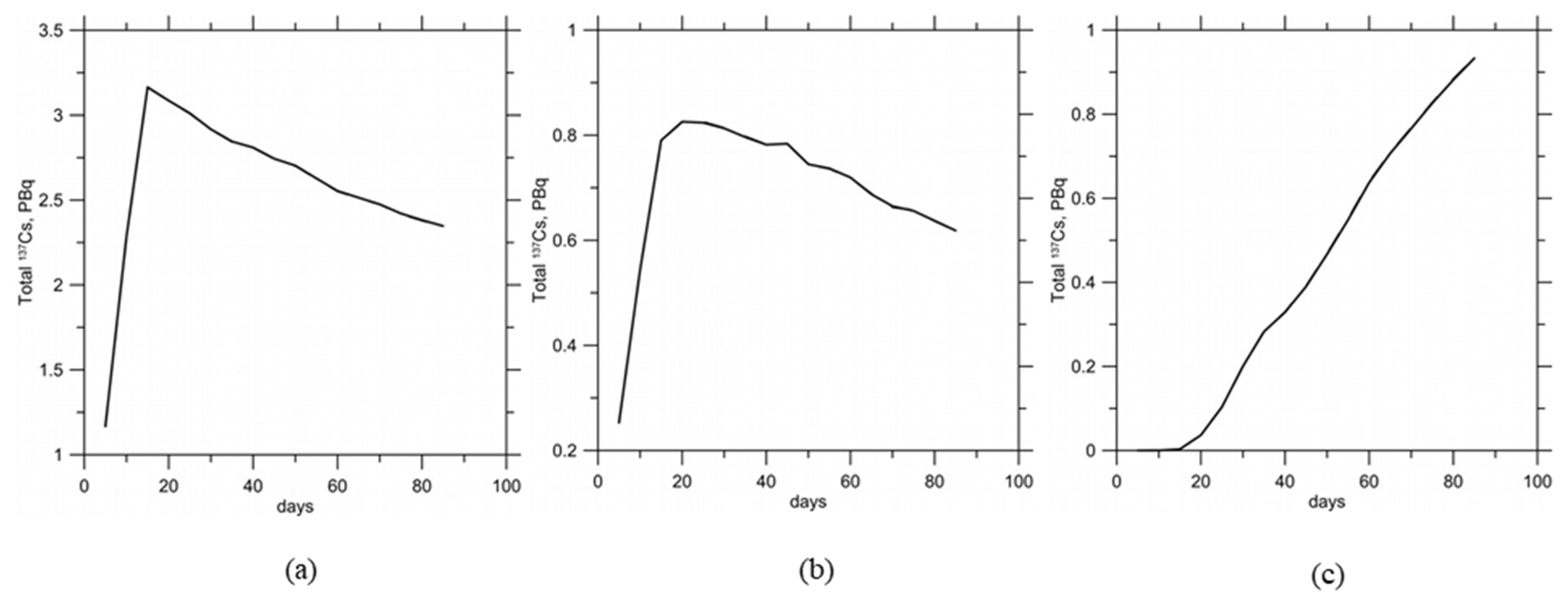

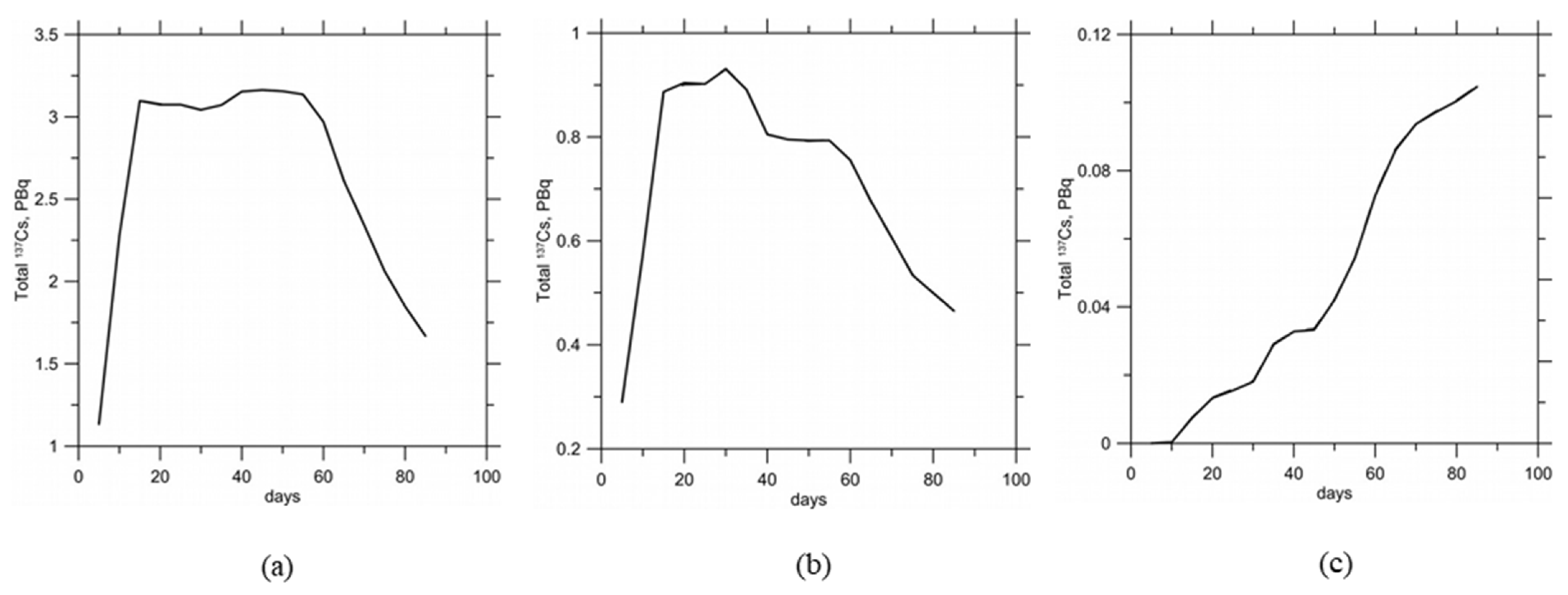
| Size Class | i | di (mm) | |
|---|---|---|---|
| Clay | 0 | 0.003 | 2300 |
| Fine silt | 1 | 0.01 | 2650 |
| Coarse silt | 2 | 0.031 | 2650 |
| Fine sand | 3 | 0.125 | 2650 |
| Coarse sand | 4 | 0.5 | 2650 |
Publisher’s Note: MDPI stays neutral with regard to jurisdictional claims in published maps and institutional affiliations. |
© 2022 by the authors. Licensee MDPI, Basel, Switzerland. This article is an open access article distributed under the terms and conditions of the Creative Commons Attribution (CC BY) license (https://creativecommons.org/licenses/by/4.0/).
Share and Cite
Brovchenko, I.; Kim, K.O.; Maderich, V.; Jung, K.T.; Bezhenar, R.; Ryu, J.H.; Min, J.E. Sediment and Radioactivity Transport in the Bohai, Yellow, and East China Seas: A Modeling Study. J. Mar. Sci. Eng. 2022, 10, 596. https://doi.org/10.3390/jmse10050596
Brovchenko I, Kim KO, Maderich V, Jung KT, Bezhenar R, Ryu JH, Min JE. Sediment and Radioactivity Transport in the Bohai, Yellow, and East China Seas: A Modeling Study. Journal of Marine Science and Engineering. 2022; 10(5):596. https://doi.org/10.3390/jmse10050596
Chicago/Turabian StyleBrovchenko, Igor, Kyeong Ok Kim, Vladimir Maderich, Kyung Tae Jung, Roman Bezhenar, Joo Hyung Ryu, and Jee Eun Min. 2022. "Sediment and Radioactivity Transport in the Bohai, Yellow, and East China Seas: A Modeling Study" Journal of Marine Science and Engineering 10, no. 5: 596. https://doi.org/10.3390/jmse10050596
APA StyleBrovchenko, I., Kim, K. O., Maderich, V., Jung, K. T., Bezhenar, R., Ryu, J. H., & Min, J. E. (2022). Sediment and Radioactivity Transport in the Bohai, Yellow, and East China Seas: A Modeling Study. Journal of Marine Science and Engineering, 10(5), 596. https://doi.org/10.3390/jmse10050596








